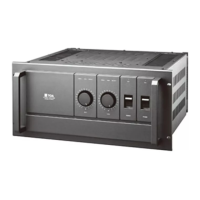Installation Precaution
Load Protection Methods
The most common of all load protection methods
is a fuse in series with the load. The fuse may be
single, fusing the overall system, or (in the case of
multi-element speaker systems), may be multiple
with one fuse for each speaker. Fuses help prevent
damage due to prolonged overload, but provide
essentially no protection against damage that may
be done by large transients. To minimize the
problem, high speed instrumentation fuses are
recommended. For a nomograph showing fuse size
vs. loudspeaker ratings, refer to the adjacent
figure.
Fault Protection Table
Fault
Excessive current due
to overloads.
Short circuits (less than
0.4-ohm).
Temperature rise of
heatsink (more than
105°C).
DC drift.
Protection
Current limiter activates
at less 2 ohms in a stereo
mode, 4 ohms in a mono
mode.
Current limiter activates
and output relay is cut.
Output relay is cut.
Indication
Peak LED illuminates.
Protection LED
illuminates.
Protection LED flashes.
Amp protection LED
illuminates.
Action
Remove excessive loads.
Minimum speaker loads
are 4 ohms in stereo
mode, and 8 ohms in
mono mode.
Check speaker lines/
systems for shorts.
Check for adequate
ventilation.
Refer to qualified
service personnel.
Restoration
Automatic restoration
after normal loads are
obtained.
Turn off power switch.
Turn on into operational
loads.
Automatic restoration
after temperature lowers
(to 75° - 95°C).
Automatic restoration
after normal bias is
regained.
- 26 -

